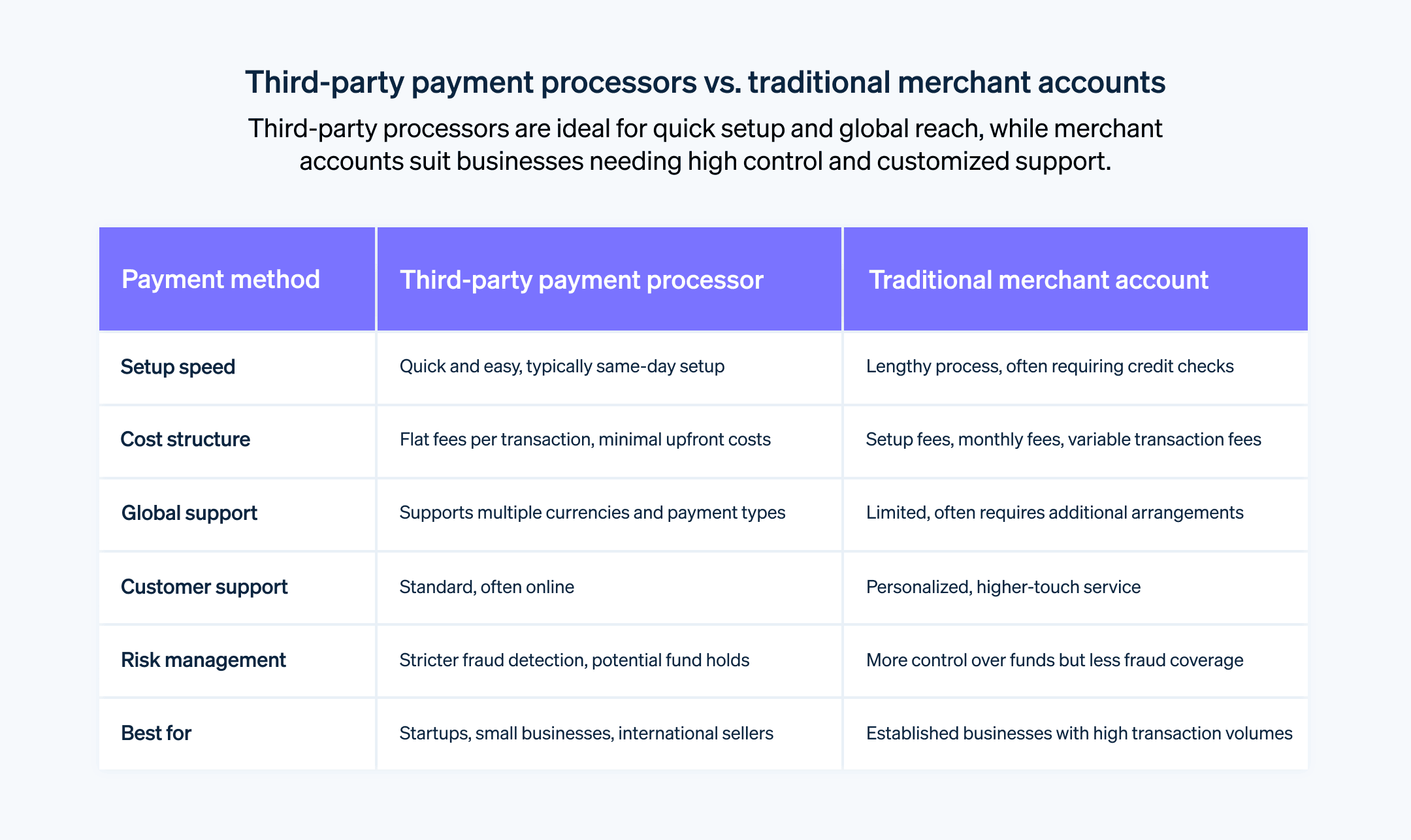2022 年的一份报告发现,线上交易占全球零售总额的 20%,预计到 2026 年将达到 24%。第三方支付处理商比以往任何时候都显得更为重要,它为许多类型的企业(从初出茅庐的初创企业到成熟的线上零售商)提供快速和安全的支付服务。
对于大多数处理客户交易的企业来说,了解这些平台非常重要。合适的支付处理商可以帮助您的企业优化客户体验、简化运营并更有效地进入新市场。下面我们将向您介绍有关第三方支付处理商的知识,以及如何为您的企业选择合适的第三方支付处理商。
目录
- 什么是第三方支付处理商?
- 第三方支付处理如何运作?
- 与第三方支付处理商合作的优缺点
- 选择第三方支付处理商
什么是第三方支付处理商?
第三方支付处理商是一项允许企业接受线上付款的服务。这些支付处理商将资金从客户的银行或信用账户转移到企业银行账户,从而协助完成客户和企业之间的交易。
第三方支付处理如何运作?
第三方支付处理商使企业能够接受各种线上支付方式,无需在银行开设和维护自己的商家账户。这是一个重大优势,特别是对于小型或新企业而言,因为与支付处理商合作可以更快、更便捷地开始接受线上付款。
传统的商家账户是一种银行账户,使企业能够以多种方式接受付款,最常见的是借记卡或信用卡 和数字钱包。在此模式下,每个企业都有一个独一无二的商家账户,这些账户附带核销要求和费用,例如设置费、月费和交易费。一般来说,与第三方支付处理商相比,商家账户还需要更长的设置流程。
第三方支付处理商(如 Stripe)将其客户的所有交易汇总到一个商家账户中,从而有效地让企业获得商家账户的功能,而无需自己费时开设账户。
下面概述了第三方支付处理商和商家账户之间的主要区别:
速度和简单性
对于企业来说,设置第三方支付处理商通常比开设商家账户更快、更容易。使用传统的商家账户,设置流程可能很长,通常需要详细的信用检查和对企业财务稳定性的审查。成本结构
通常,第三方处理商对每笔交易收取固定费用,而商家账户通常混合收取设置费、月费和可变交易费。对于小型企业或销量较低的企业,第三方处理商的成本结构可能比商家账户的成本结构更有利。风险管理
由于第三方处理商汇集了来自许多企业的交易,因此他们通常具有更严格的欺诈检测 系统,当检测到可疑活动时,它们可能更有可能冻结账户或冻结资金。客户支持
商家账户通常提供更加个性化的客户支持,而第三方处理商由于合作的企业数量众多,通常提供个性化程度较低的标准在线支持。支付灵活性
第三方处理商通常支持更广泛的支付方式和货币,这对于跨国运营或希望为客户提供更多支付选项的企业来说非常有利。例如,Stripe 支持超过 135 种货币,这使企业能够在广泛的全球市场开展业务,并以首选货币接收提现。
虽然第三方支付处理商让企业可以轻松快速地开始接受线上付款,但它们也有自己的风险。选择第三方处理商还是传统商家账户将取决于企业的具体需求和情况。

与第三方支付处理商合作的优缺点
与第三方支付处理商合作可以为企业提供诸多优势,尤其是对于小型企业或初创企业。然而,支付处理商也面临着一系列挑战。以下是第三方支付处理商的优缺点:
优点
易于设置
与传统商家账户相比,第三方支付处理商的设置通常更容易、更快捷。例如,Stripe 允许企业搭配使用开发人员友好型 API 库与低代码或预建解决方案快速开始接受付款。初始成本更低
第三方支付处理商通常没有设置费或月费,这使其成为小型企业或销量较低的企业的更实惠选择。下面概述了 Stripe 简单、透明的定价结构。全球交易
它们通常支持多种货币和支付方式,使企业更容易向全球客户销售产品。简化支付流程
它们处理支付流程的所有方面,包括支付安全、欺诈检测和遵守支付行业法规。
缺点
更高的交易费用
与传统商家账户相比,第三方支付处理商通常收取更高的每笔交易费用。但是,情况并非总是如此,这取决于您与哪个提供商合作。搁置或冻结的风险增加
由于处理商与大量企业打交道,因此它们有时会在检测到可疑活动时自动冻结账户或扣留资金。较少控制
使用第三方处理商,企业对交易过程的控制较少,必须依赖处理商的系统和规则。更少的客户支持
由于它们服务的企业数量很大,第三方处理商可能无法提供与专用商家账户相同级别的客户服务。情况并非总是如此,但在评估您的选择时必须牢记这一点。
当然,并非所有第三方支付处理商都有相同的优缺点。这取决于提供商的特质以及它对特定业务需求的满足程度。
选择第三方支付处理商
选择合适的第三方支付处理商对您的企业来说可能是一个重要的决定。合适的处理商可以简化您的付款运营,让客户更顺畅地进行交易,甚至扩大您的潜在市场。但是,错误的选择可能会导致不必要的高额费用、服务中断或客户交易问题。面对如此多的选择,在做出决定之前,请考虑您企业的具体需求和情况。以下是需要牢记的几个重要因素:
了解您的业务需求
每个企业都是独一无二的。考虑销售量、平均交易规模、您销售的产品或服务类型以及客户偏好的支付方式等因素。例如,如果您经营一家为国际客户提供服务的网店,则需要一个支持多种货币和支付方式的处理商。在有限的市场中拥有几个实体零售点的小型企业可能不需要相同类型的支持。
评估费用结构
不同的支付处理商有不同的费用结构。有些对每笔交易收取固定费用,而另一些则可能会按交易价值的百分比收取费用。留意任何隐藏费用,例如拒付 手续费、月费或终止费。了解这些成本以及它们将如何影响您的利润。
考虑支持的支付方式
您的客户可能更喜欢不同的支付方式,例如信用卡、借记卡、数字钱包或银行转账。选择支持多种支付方式的支付处理商可以改善客户体验并有可能增加销售额。
检查处理商的声誉和可靠性
寻找来自其他企业的评论或推荐。研究处理商服务的可靠性以及它们停机的频率。此外,还要考虑处理商的客户服务声誉。如果您选择与之合作并遇到问题,则需要及时而有用的客户支持,最好是通过各种渠道(电子邮件、聊天、电话等)。
评估安全性
确保支付处理商符合所有相关的安全标准,例如 PCI DSS(支付卡行业数据安全标准)。它应该使用加密和其他安全措施来保护客户的支付信息。
考虑可扩展性
随着业务的增长,您的支付处理需求可能会发生变化。选择可以随您的企业一起扩张并根据需要处理增加的交易量的处理商。
选择第三方支付处理商是一项重大决定。给自己留出时间研究各种选项并做出明智的选择,您就可以与支持您的业务目标的支付处理商合作。
本文中的内容仅供一般信息和教育目的,不应被解释为法律或税务建议。Stripe 不保证或担保文章中信息的准确性、完整性、充分性或时效性。您应该寻求在您的司法管辖区获得执业许可的合格律师或会计师的建议,以就您的特定情况提供建议。